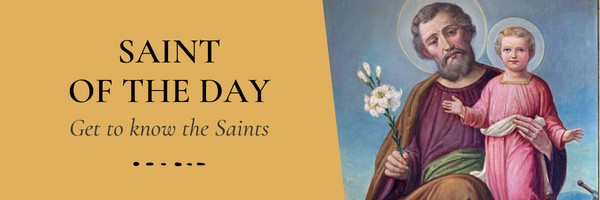 Dear readers, Catholic Online was de-platformed by Shopify for our pro-life beliefs. They shut down our Catholic Online, Catholic Online School, Prayer Candles, and Catholic Online Learning Resources essential faith tools serving over 1.4 million students and millions of families worldwide. Our founders, now in their 70's, just gave their entire life savings to protect this mission. But fewer than 2% of readers donate. If everyone gave just $5, the cost of a coffee, we could rebuild stronger and keep Catholic education free for all. Stand with us in faith. Thank you. Help Now >
Dear readers, Catholic Online was de-platformed by Shopify for our pro-life beliefs. They shut down our Catholic Online, Catholic Online School, Prayer Candles, and Catholic Online Learning Resources essential faith tools serving over 1.4 million students and millions of families worldwide. Our founders, now in their 70's, just gave their entire life savings to protect this mission. But fewer than 2% of readers donate. If everyone gave just $5, the cost of a coffee, we could rebuild stronger and keep Catholic education free for all. Stand with us in faith. Thank you. Help Now >
Diego Rodriguez de Silva y Velazquez
FREE Catholic Classes
Spanish painter, b. at Seville 5 June, 1599 (the certificate of baptism is dated 6 June); d. at Madrid, 7 August, 1660. His father, Juan Rodriguez, belonged to the Portuguese family of Silva; the child took the name of his mother, Gerónima Velazquez. He entered the studio of the aged Herrera, but could not stand his temper, and soon left for the studio of Pacheco, whose school at Seville was the most frequented. Although one of the most tiresome of romanticizing painters, Pacheco was a cultured mind, appreciative of a genius opposed to his own. As a critic, poet, and man of the world, Pacheco was the centre of the first literary salon in the city, and from this society young Velazquez received an education through contact and conversation with superior men. Before he was twenty he had married Pacheco's daughter Dona Juana. Two daughters were born to him before 1622, when the young painter decided to seek his fortune at Madrid.
Here, through Canon Fonseca, a friend of his, who held a post at Court, he was enabled to visit the royal collections at the Alcazar, Prado, and especially the Escorial, with its matchless collection of Tintorettos and Titians. This was the sole benefit of his visit, and after some several months Velazquez returned to Seville. When Philip IV raised the Sevilian Olivarez to power, Fonseca summoned Velazquez back to Madrid, and he obtained permission to paint the king's portrait in the court of the riding school. This portrait, now lost, was an event. Thenceforth Velazquez had the exclusive right to paint the person of the king. By a patent of 31 October, 1623, he was appointed painter of the chamber, with a salary of twenty ducats payable out of the appropriation for court surgeons and barbers.
For thirty-seven years Velazquez's fortune lasted; even the fall of Olivarez, in 1643, did not lessen the royal favour towards Velazquez, who rose one degree in official functions with each year, becoming in turn gentleman of the bed-chamber, master of the wardrobe, and finally (1652) aposentador , or quartermaster of the royal migrations. His life was now that of a functionary occupied with multifarious duties in a Court noted for the oddities of its protocol, and the strictness of its etiquette. This monotonous and somewhat empty existence was varied by sojourns at Aranjuez and gala excursions which entailed upon Velazquez serious cares and unpleasant tasks; only two journeys to Italy, twenty years apart (1629, 1649), brought him a breath of fresh air, freedom, and relaxation. The artist, however, did not suffer in consequence of these conditions. He had solicited all these offices, and they brought him consideration and honour. At the end of a corridor at the Alcazar, in a world of ministries and bureaux, he lived his own life, which he has shown us in a picture by his son-in-law, Mazao, in a vast, bare Arabian apartment, with a rose in a glass shedding its petals before a bust of the king. Philip, indeed, always carried about with him a key to the studio of Velazquez, and went daily to spend an hour there--to find a brief distraction from the sense of weariness which is expressed in his melancholy countenance. This intimacy was Velazquez' romance; it lends a peculiar charm to the long series of portraits the painter made of his royal friend.
This peculiar situation makes Velazquez a figure somewhat apart in the Spanish School. In an art almost exclusively religious he alone is a lay painter ; he alone scarcely ever painted for convents and churches; he alone had occasion to paint historical pictures, mythological scenes, and nudes; he was almost alone in avoiding the scenes of martyrdoms and scenes of torture so characteristic of Spanish painting. These facts, however, point to no conclusion concerning Velazquez' sentiments; for instance, it does not follow that he was not a good Catholic, though it may well be that he was not a mystic.
Compare the Olympian, majestic serenity of his splendid "Crucifixion" of the Prado, with the distorted, pale Christs of Theotocopuli ; the evident difference is that between simple respect and religious passion. At bottom no one is less unrestrained in his art than Velazquez, no one gives us fewer confidences nor fewer opportunities to read the secret of his heart. He felt no compulsion to produce something; he was not tormented by any thirst for glory or for self-expression. About 200 canvases constitute his entire output, three-quarters of them portraits, and the facility exhibited borders on the marvellous. Velazquez seems to have had no imagination ; his work is perhaps the most remarkable existing example of exclusively naturalistic and realistic art. He never invented anything; he never showed any desire to seem original; he only sought more and more rapid and artistic ways of expressing facts without any intermingling of personality, painting with the same indifference still life or an historical scene, a king or a buffoon, the body of a young girl or a monstrous dwarf; sweeping the universe with his imperturbable gaze and embracing without love or repugnance all forms of life, whether beautiful or hideous, like an impassive mirror of nature. His whole art, his whole ideal, all the interior life and the progress of this incomparable painter, lay in a more and more perfect reproduction of things. It may be said that, starting from a pure realism, Velazquez reaches in his last works a sort of impressionism or phenomenalism, and it is this which for forty years has constituted him the foremost master of modern painting.
His first works were those executed at Seville before his journey to Madrid and his first contact with the Italian masters. These belong to the class of bodegones , or pictures of still life, and are exclusively mere studies. The young painter sought to express simple objects, fruits and vegetables, kitchen utensils, jars, and alcarazas ; he was studying, and he learned to translate things directly, constructed his vocabulary without troubling masters, and consulted only nature itself. This was the method of Rembrandt's early work, as also of Chardin's and, in more recent times, of Cézanne's. Most of the important pictures of this early period are now outside of Spain. Such are "The Water-Carrier of Seville" (c. 1618) (Apsley House); the "Two at Breakfast" (same collection); the "Three at Breakfast" (the Hermitage); the "Blind Woman " in the possession of Sir Francis Cook; "Christ in the House of Martha and Mary" (National Gallery, London ), which, despite its title, is a scene at an inn with two coarse women ; lastly the "St. Peter" of the Beruete collection and the "Nativity" of the Prado (1619), which is the author's largest picture of this date and likewise the best of all.
During the seven years (1623-29) which preceded the first journey to Italy we know that he painted, besides various portraits mentioned below, a large composition called the "Expulsion of the Moriscoes" (1677) which unfortunately perished in the burning of the Alcazar and not even an engraving of it remains. But to the same period belongs an important picture, the "Bacchus", or "The Drunkards", dating doubtless from 1628, and permitting us to judge of his progress. This, also, despite its mythological title, is a very real subject; each face is a portrait, one of those portraits of rustics and beggars, a company recruited from a picturesque rabble, which became fashionable about the beginning of the eighteenth century through the reaction against the idealist system, and which in Spain furnished the material for the picaresque romance. Otherwise the work is magnificent: each head, with its brick-dust tint and sunburnt skin, is superbly forceful and brilliant; the bodies of the two half-clad lads are splendid bits. But, as a whole, the picture is cloudy, lifeless, heavy, and characterized by a crass sensuality.
At this juncture Velazquez made the acquaintance of Rubens, who had come to Madrid on a mission to the King of Spain. Rubens' prodigious activity stirred the apathy of the Andalusian artist; animated by curiosity and a new insight, the young man set out for Italy shortly after the departure of the Fleming. He stayed there a year, visited Venice and Rome, and returned by way of Naples, bringing back from the journey the fruit of contact with Italy and the antique, a new conception of the meaning of art. This was soon made manifest in two large pictures which Velazquez painted after his return, but had perhaps begun in Italy, "Joseph's Coat" ( Escorial ) and the "Forge of Vulcan" (Prado) (c. 1631). As in "The Drunkards", the idea and characters, the subject and types, were, despite the title, of a popular nature ; the "Forge" especially is a genre picture taken from life and but little altered. He here begins to employ that silvery and exquisitely limpid tone which he constantly made more delicate and fluid, and which was thenceforth the great resource of his poetry and the chief agent of his transformations.
This progress of art in Velazquez is shown chiefly in the work of this period, "Christ at the Column" (National Gallery, London ) and the "Crucifixion" of the Prado, which Théophile Gautier has compared to a beautiful ivory crucifix on a background of dark velvet. But Velazquez' genius reached its grandest expression at this time in the famous and magnificent picture of "The Lances" (see SPAIN, full-page illustration). The subject is well known: the surrender of Breda, the meeting of the two approaching forces, Nassau followed by his Dutch gunners, Spinola at the head of the picket of lances which gives its name to the work, and the charming gesture of military comradeship, whereby the victor welcomes the vanquished. Two races face each other in a living contrast of faces and costumes, an abundance of portraits, picturesqueness, and colour, a charm and brilliancy of expressions which perhaps have never been equalled in any school. The beauty of the horse, the spirit of the arrangement, the apparent facility, the grandeur of the landscape, the quantity of ambient air, the breadth of the colour scheme, the particular sonorousness of tone, the style, at once natural and joyfully heroic, constitute this immense canvas a unique triumph at this period of Velazquez' work. The central group impersonates Spanish courtesy in its noblest and most chivalrous aspect. The importance of the subject, the dimensions of the work, the incomparable success of plastic expression, picturesque and natural interest with a significance for Spain which some years later "The Night Watch" was to have for Holland, while for clearness of expression, value of colours and physiognomies, Velazquez had the advantage. We may seek in vain in the seventeenth century for anything comparable to this historic canvas. Yet it may be asked is this Velazquez' masterpiece? Has it the immense virtuosity presumed for such a canvas as properly its own? Is not this decorative grandeur borrowed from Veronese or Titian ? The very popularity of the work shows that it was according to a received formula, and if Velazquez had died immediately after "The Lances", he still would have been one of the foremost painters of the world, one of the most wonderful artists of the Venetian family, but we should not have known the most intimate and original side of his genius.
For twenty years his portraits formed the chief part of his work. "He only knows how to paint heads", his enemies said of him. "They pay me a great compliment", replied the phlegmatic artist, "for I know of no one else who can do as much." The royal family, Philip IV, his brother the cardinal infante, his two wives, his young son Don Balthazar Carlos, the infanta Margaret, constitute nearly all the contributions to his incomparable gallery; from 1624 to 1660 there are more than twenty portraits of the king himself, and it is doubtful if there exists elsewhere a similar artistic monograph or biography of the same individual; but taken together with those of his circle--his brother, his wives, and his children--these portraits assume a new value and constitute a human document of the first order; they form the reconstruction of a vanished circle, the natural history of the agony of a race. There is to be found nowhere a collection of portraits of such powerful and pathetic interest.
The portraits of Velazquez are distinguished for their absolute truth and the total absence of striving for effect. No royal personage, especially in the seventeenth century, was ever surrounded with less pomp; compared with these portraits Rigaud's "Louis XIV" seems theatrical and bombastic; Van Dyck's "Charles I" foppish, beruffled, and flippant. The black dress, black cloak, black shoes and stockings, the puritanical-looking golilla or Spanish collar, give to Velazquez' portraits a strange severity; we feel the supreme dignity and distinction of a grandeur which is not indebted to costumes or accessories; the prince shows himself and wins our recognition by his presence alone: Yo el Rey . A new stage is marked by the portraits of the king, the cardinal infante, and Balthazar Carlos in hunting costume, made about 1635 for the decoration of a pavilion of the Torre del Pareja; between these three figures treated in a tone of bistre bordering on monochrome the artist has sought new relations and a sort of harmony expressed in the motif, the landscape, the atmosphere, and above all the choice of the tone. An exercise of the same kind, with immense progress in the orchestration, consists of the portraits of the king, Olivarez, and the infante, on horseback, made to adorn a hall of the Prado. After so many masterpieces, it is still a question whether Velazquez ever produced anything happier or more complete than the splendid Infante Balthazar Carlos astride his little chestnut horse, galloping briskly on an April morning on the bare and joyous slopes of the sierras.
Besides these royal series mention must be made of some separate portraits, such as the "Lady in Black" of the Museum of Berlin, the full-length portrait of Admiral Pulido Pareja (1639, Longford Castle), and especially the face of the sculptor Martinez Montanez (Madrid, c. 1645), one of the master's simplest and most extraordinary works. To this period (from 1640) belong two new series in which Velazquez' formula becomes elaborated into his latest manner and the qualities of observer, artist, and harmonist are blended to produce the unparalleled masterpieces of 1655. These are the two series of "Dwarfs" and "Infantes". The seven or eight pictures of dwarfs--the "Niño de Valecas" or the "Boho de Coria " possessed by the Museum of Madrid --afford a glimpse of the familiar life of the Spanish Court in the seventeenth century which nothing can replace; without them we could not imagine the hardness of this world of feasting and luxury which, to enhance its joy by contrast, suffered all the miseries of life to creep in its shadow. The unconscious cruelty which takes such pictures for granted is what Velazquez has in common with the ferocious side of his race and, for example, with the sanguinary art of Ribera. This collection of frightful studies, these pictures of cripples, goblins, abortions, might serve to illustrate a treatise on teratology. The painter shows neither affection nor disgust; he was no repugnance to painting what nature is not ashamed of creating and what the sun shines upon. This gallery of monsters is, after all, one of his most fascinating creations.
In the parallel series of portraits--the infantas at Vienna, Madrid, and in the Louvre--the great painter's otherwise far from tender work is endowed with the peculiar characteristic derived from the presence of women. And yet a strange picture, indeed, of the eternal feminine is presented by these young figures, paralyzed by etiquette, deformed by ridiculous and extravagant fashions. The artist, thenceforth the finished master of his technic, and possessed of the language which was to be the element of his last works, confined himself to playing like a virtuoso with details of reality which took his fancy. He no longer sought to imitate nature itself, to paint slavishly the substance of things, but was content to barely evoke the appearance and arrange on his canvas just what would suggest the whole impression. He ceased to paint facts or, rather, the only facts which he depicted were his intimate sensations. For him, reality henceforth consisted only in the reflexion of things perceived in his consciousness, and this abbreviated reflexion, this new and inner reality, was what he threw into his picture. Thus proceeding slowly and from experience to experience, the painter passed from the mere copying of material facts to the most individual and original expression known in painting. In this period (1649-50) occurred the painter's second journey to Italy, commemorated by three or four masterpieces, the two landscapes of the Villa Medici, preserved at Madrid, which possess all the grace of the most delightful Corots, and the portrait of Velazquez' mulatto slave Juan de Pareja (Castle Howard), with which the artist preluded the magnificent portrait of Pope Innocent X (Palazzo Doria), the finest portrait of a pope save Raphael's Julius II.
On his return to Madrid the painter, now definitely freed from all shackles, and strong enough to handle all ideas as he pleased, produced one after another the most decided, and most precious of his works. Such, for example, were the two famous philosophers, the "Æsop", and the "Menippus" of the Prado, the most beautiful example of this class of Spanish mendicancy akin to the "Drunkards" of thirty years earlier. Such, likewise, were the two companion pictures, the only existing fragments of an entire decoration-the "Mercury and Argus" of the Prado and the "Venus with the Mirror" of the National Gallery. The "Mars" and the "Coronation of the Virgin", at the Prado, are less pleasing, and original works. For a long time, owing to the nature of his ideas and the constant development of his researches, Velazquez devoted himself to the solution of a more important problem. We have seen how in "The Lances" he had attempted historical painting, and what prevented him from succeeding therein. Thenceforth he devoted himself to a new idea through a whole series of works, to express directly, in the fashion of a portrait, not merely an historical scene nor a single figure but a complete action of daily life. Thus, small pictures such as the "Boar Hunt" (Callace Collection, c. 1636), "Balthazar Carlos in the Riding School" (Wallace Collection, c. 1640), and the "View of Saragossa" lead us up to Velazquez' grandest works, those which contain all his genius and present the highest expression of his art, such as "The Spinners" and "The Maids of Honour" (Las Meninas) (c. 1655-56). In subject they are both genre pictures, but of hitherto unknown dimensions and treated in the "historical" size. The former shows a workshop which is being visited by two ladies; the latter, an inner chamber of the Alcazar in which Velazquez is shown painting the young infanta, who is surrounded by her ladies in waiting, her dueñas, her dwarfs, and her dog. Into these everyday scenes is introduced an element of selection, of fantasy, caprice, genius--a something subjective and purely individual, without which such pictures could never have been conceived. Such groups as these were formed again and again in the noisy and overheated work-rooms or the coolness of dark palaces, but they demanded a supreme artist.
To translate these wholly intellectual facts of a quite peculiar order of existence, the artist did not make use of known lines or colours; he employed splashes, vague coloured splashes without parallel in form and with no more relation to the world of real facts than the colourless dust on the butterfly's wing bears to the rich diapering which the eye perceives. Everything becomes more elliptical, more uncertain and unreal, and assumed an appearance of a special nature, no longer that of visible and material phenomena, but of their reflexion in the artist's soul, on a rarely sensitive surface; the operations of the hand become imperceptible and mysterious, and show an agility and caprice bordering on the miraculous ; the complete whole takes form before our eyes with a verisimilitude which seems fantastic, and we have no longer a meaningless scene, but a real vision. These two works, writes Raphael Mengs , are the theology or the "Summa" of painting. They seem to exist outside of all the expedients of art and as by a mysterious fiat. Through them an entirely new path was opened to the painting of things. Every other scene of life has the same claim to be depicted, provided it has for observer and interpreter such a witness as Velazquez; it was a new viewpoint of nature, a method of fruitful and infinite application. We are assured that on seeing the "Meninas" the king was so charmed with the work that he perceived only one oversight, and taking up a brush, painted on the breast of the artist's own portrait the grand cross of St. James. Whatever the worth of the legend, the coveted order was none the less granted to Velazquez 12 June, 1658. He had given proof of his limpieza de sangre , that is, that he had in his family not a drop of Jewish or Moorish blood, that he had never worked for his living, that he had never made a trade of painting, that he had never practised his art save as a recreation and in the service of the king.
To these last years belong some busts (london, Turin, Madrid ) which Velazquez made of the prince, stirring works, in which we discern beneath the coldness of the mask the interior tragedy which froze the charming countenance of the poet that Philip IV had been. The last, and one of the most charming, of Velazquez' works is the "Anchorites" of the Prado, which is perhaps his most airy and luminous, his tenderest and most poetic work. After his return from Italy, filling the post of royal aposentador , he was charged with all the preparations for the journey on the occasion of the Peace of the Pyrenees and the marriage of Louis XIV with the infanta. Worn out by this excess of labour, the painter was attacked, on his return, by a fever which proved fatal. Philip IV keenly felt the loss of his friend. In the margin of a report of the Junta de Obras y Bosques, ordering that 1000 ducats of the painter's estate be returned to the budget of the Alcazar, of which Velazquez had been superintendent (proving that his management had been negligent and irregular ), the King wrote the heart-broken words: "I am crushed" ( Quedo adbatido ).
In his sphere Velazquez had no superiors and perhaps no equals. Not only must all painting compared with one of his seem artificial and forced, so that in the wonder-crowded Prado, he seems the sole painter, but we must discern in him one of the finest minds and serenest souls that has ever been on earth, a glance capable of embracing and understanding nature, the whole of life without omission or scorn, passion or hatred, and of reproducing it in its true aspect as it appeared in the mirror of his thought. Alone of all the Spanish painters, although the most local of all, he is universal. But no more than any other master of his class did he form pupils worthy of him. No school emerged from "The Spinners" and "The Weavers". Rare pictures were connected with them, such as the family picture of J.B. del Mazo, mentioned above, and the "Santa Forma" of Coello in the Escurial, after which we find no companion to "The Maids of Honour" until Goya's "Family of Charles IV". But modern art is chiefly connected with Velazquez; the work of Whistler, for example, or of Lucien Simon, to mention only these two, are attempts to utilize the lesson of the last works of Velazquez. It was more than two centuries before European painting reached the point to which extraordinary genius had brought this Catholic Spaniards of the time of Philip IV.
Join the Movement
When you sign up below, you don't just join an email list - you're joining an entire movement for Free world class Catholic education.
- Advent / Christmas
- 7 Morning Prayers
- Mysteries of the Rosary
- Litany of the Bl. Virgin Mary
- Popular Saints
- Popular Prayers
- Female Saints
- Saint Feast Days by Month
- Stations of the Cross
- St. Francis of Assisi
- St. Michael the Archangel
- The Apostles' Creed
- Unfailing Prayer to St. Anthony
- Pray the Rosary
![]()
Copyright 2025 Catholic Online. All materials contained on this site, whether written, audible or visual are the exclusive property of Catholic Online and are protected under U.S. and International copyright laws, © Copyright 2025 Catholic Online. Any unauthorized use, without prior written consent of Catholic Online is strictly forbidden and prohibited.
Catholic Online is a Project of Your Catholic Voice Foundation, a Not-for-Profit Corporation. Your Catholic Voice Foundation has been granted a recognition of tax exemption under Section 501(c)(3) of the Internal Revenue Code. Federal Tax Identification Number: 81-0596847. Your gift is tax-deductible as allowed by law.













